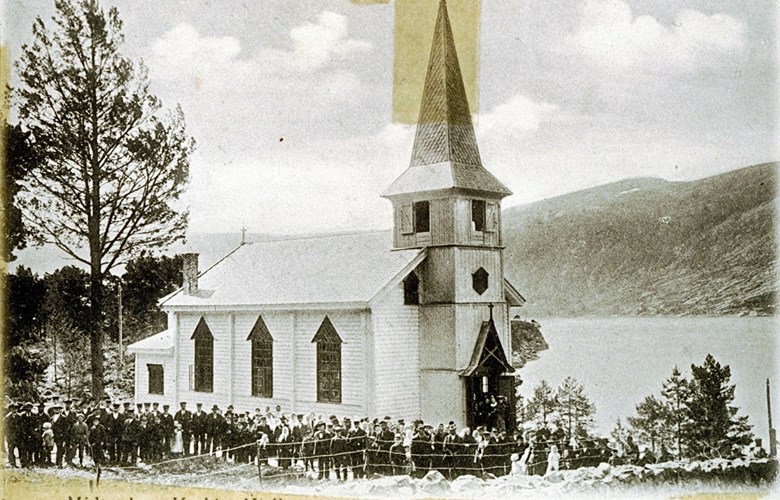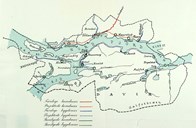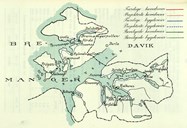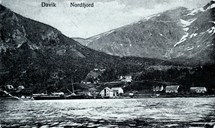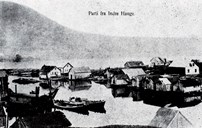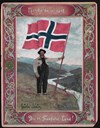The municipality of Bremanger in 1905
In 1905, the present Bremanger municipality consisted of the municipalities of Bremanger and Davik. Bremanger became a municipality in its own right in 1866 when it was separated from the Kinn municipality. The municipality was identical to the Bremanger parish which again consisted of the sub-parishes ("sokns") of Bremanger and Midtgulen. The Davik municipality was established in 1837 and was identical to the Davik parish which consisted of the "sokns" of Davik and Rugsund, in addition to Ålfoten "kapellsokn". The Davik municipality covered an area which today belongs to the municipalities of Vågsøy and Eid.
In 1964, the farms of Husefest and Breivik were transferred from Bremanger to Flora. The following year, the municipality of Bremanger was extended with large areas of the Davik municipality. The whole area south of the Nordfjord, with the exception of the islands of Risøy, Gangsøy, Grindøy, Husevågøy and Klovningen was included inside the boundaries of Bremanger. The northern side of the Rugsund "sokn" was transferred to Vågsøy, and the northern side of the Davik "sokn" to Eid.
In 1900, the population of the Bremanger municipality was 2330 and of the Davik municipality 3382. Fisheries were the most important industry, but in Davik there was some agriculture. The most important commercial centres were Kalvåg, Davik and Rugsund. Both municipalities had savings banks (Bremanger Sparebank and Davik Sparebank).
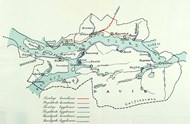

The area today covered by the present municipality of Bremanger had ten post offices (Kjelkenes, Botnane, Bremanger, Bremangerpollen, Berle, Rugsund, Davik, Isane and Ålfoten), a telegraph exchange at Kalvåg and long-distance telephone exchanges at Kalvåg, Bremanger, Kjelkenes, Botnane, Rugsund, Botnane and Davik. Steamers had stops at Kalvåg, Bremangerpollen, Botnane, Kjelkenes, Berle, Hennøy, Skatestraumen, Rugsund, Davik, Isane and Ålfoten. (Davik municipality also had stops at Almenning, Bryggja and Haus, today within the boundaries of the municipalities of Vågsøy and Eid.)
The road network was badly developed. The only road in the then municipality of Bremanger was 1.2 kilometres long and went from Kalvåg to the Frøya church. From Bryggja in the then Davik municipality the main road led north to Sunnmøre. There was a road from the farm Vik at Ålfoten past Sigdestad to the farm of Førde (5.7 kilometres). As was the case elsewhere in the county, the many fjords constituted the main communication artery.
"a strong national sentiment"
Throughout 1905, people waited anxiously for the latest news concerning the union between Norway and Sweden, on the development of the so-called consulate issue in the spring (Norway wanted a separate consular service), on the dissolution of the union on 7 June, on the referendum on 13 August, on the negotiations in Karlstad, Sweden, on the issue of monarchy and republic, and the new royal family in November/December.
On 8 March, the local paper "Fjordenes Blad" reported a "strong national sentiment" which was expressed by a party organized by the youth association of Kalvåg and the temperance lodge "Frøya". The newspaper reported that visiting fishermen from the whole coast up to Nordland took part. "At the party there was an atmosphere of strong national sentiment. Men from various parts of the country expressed views about their anger with the behaviour of Sweden, as well as their agreement that the nation should stand united and firm on a manly decision - regardless of the outcome of the union issue."
Other issues and events than the dissolution of the union
The dissolution of the union was the all-important issue throughout 1905, but a number of other issues as well caught the attention of people that year. The language issue - the movement to get more people to use the "nynorsk" variety of Norwegian - was a burning issue, as was the emigration to America.
Newspapers filed short or lengthy articles about big and small events throughout the county, elsewhere in the country, as well as abroad.
Communications were constantly improving, and in 1905, "Fjordenes Blad" reported that two new long-distance telephone exchanges had been established at Botnane and Davik. On 24 June, "Fjordenes Blad" there was an obituary for the widow Antonette Friis. It appears to be one of her servant maids who has written these words. "A person always willing to lend a helping hand, a woman who lived more for others than for herself, has now passed away. (..) However, we remember her best when she on Christmas Eve in her living room handed out presents to all her servants, or when she sat down at the piano on New Year's Eve and played the melody "Tiden svinder, tiden rinder".("Time passes on")"
On 12 August, there was an article in "Fjordenes Blad" on a special St Olaf's Day service on the mountain Tofteviten. Tofteviten has been used as a military observation point, and in 1905, people could see remnants of the last time the mountain post was used in a military conflict. "The last time the warning beacon was last used seems to have been in the year 1808." But in 1905 it was the special service that was the reason why people gathered at the mountaintop of Tofteviten. "On Sunday 30 July, the day after St Olaf's Day, a group of young and old people met at Viten, most of these coming from Almenningsstrandi and some further in the fjord, close to hundred persons altogether. On the site of the old observation post they wanted to celebrate the memory of St Olaf. It was as if everybody felt the solemnity of the occasion at this site so full of memories, and then the service began with the singing of hymns and a reading of the St Olaf sermon, followed by more hymns."
Fisheries and agriculture in 1905
On 8 March, "Fjordenes Blad" reported from Kalvåg on the herring fisheries. "There is so much hustle and bustle here that nobody who was not present could ever imagine it. (..) Many boats made two catches a day, but then most of the night passed before the boat was emptied for the second time. The work was carried out quickly with many a comment uttered in jest."

Later that year, on 11 November, "Fjordenes Blad" ran an article on the early arrival of winter in 1905. "At the first nights of frost, people had barely finished the harvesting, only turnips, and perhaps some potatoes were still not harvested. In Nordfjord some days ago, nearly all the potato fields were still not harvested." Earlier that year, the weather had caused problems for the farmers. "Throughout the year the haymaking has been slow. There was a good crop of hay this year, but just as people had finished cutting the hay, it rained incessantly for several weeks, so the quality of the hay was substantially deteriorated. The second cutting of hay was equally bad, not to mention the grain which was very late. As far as potatoes are concerned, the crops were perhaps better than expected. Nowadays people are looking for heather and other plants to supplement the fodder for the animals, but icy conditions cause problems in many places. It is too cold to do any work in the field as the ground is frozen."
The language issue
In the rural areas it was mostly the youth associations that worked to introduce the "nynorsk" variety of the language, as well as fighting for the dissolution with Sweden. At Midtgulen the youth association "Framover" worked hard to introduce the so-called Blix hymns. They won this fight in 1905 when a ballot in the church ended with 79 votes for the introduction and 11 against.
Some prominent persons
There was a municipal election in 1904, and Apollonius Liljedal Rosenlund (cantor) was elected mayor of Davik and Kr. Indrehus (farmer) mayor of Bremanger. In 1905, Bremanger municipality had two vicars; Halvdan Støp and Gunnar Ollmar, the latter being appointed vicar in May 1905. Ingvald Eide was vicar at Davik. The following is written about Eide in Davik kyrkje: "In terms of spiritual guidance, he was marvellous. Those who met him, were helped both in life and death. Bishop Hognestad said about him after the first visitation that he had learned much from talking with him. He was one of the finest vicars he had met." Bernt Øysteinson Håland was bailiff at Bremanger and Arnoldus Lem was bailiff at Davik.
Clubs and organizations
In the area of the present-day municipality of Bremanger there were in 1905 five youth associations ("Davik ungdomslag" established in 1901 as "Davik kristelege ungdomslag", Endal (1903), Frøyens (1894), "Leirgulen kristelege ungdomslag" (1905) and "Ungdomslaget Framover" (1898)). In addition, there were eight rifle associations: (Botne (1900), Botnane (1900), Davik (1905), Frøyen and Kalvåg (1891), Gulen (1884), Rylandspollen (1900), Skatestraumen (1895) and Ålfot (1884)). There was a number of women's associations, mission supporters, lodges and Sunday school, as well as an association working for the travelling people.
17 May 1905
Throughout the country, more people than usual took part in the 17 May celebrations that year. The following day there was to be a debate in the Storting concerning the proposition on the consular issue. At Midtgulen, the youth association "Framover" had got both a new house and a new banner. Thus they were allowed to lead the 17 May procession with their new banner. The route of the procession according to "Fjordenes blad" (10 June) "..from Kjelkenes through the pine forest to the Midtgulen church, where they sang Blix hymns and teacher Daviknes played the organ. Then they returned to Kjelkenes where there was a big party for the day in the new building, with speeches given by Mr Indrehus, Mr Daviknes, and others.".
7 June 1905
7 June 1905, the very day when the union was dissolved, was an ordinary working day, but people all around the country waited in excited anticipation for the latest news from the capital and the Norwegian Parliament (Stortinget). As the news spread, people hoisted flags, and in some places telegrams were sent to the authorities to show their appreciation. Stortinget issued a proclamation on the dissolution of the union. The Ministry of Church Affairs sent an appeal to the vicars, asking them to read an announcement in the churches on the following Sunday - Whit Sunday - on 11 June, or later.
The referendums - the right to vote and election committees
There were two referendums in 1905:
1) Sunday 13 August, when people were asked to say 'yes' or 'no' to the dissolution that had been passed by the Storting on 7 June.
Sunday 12 and Monday 13 November, when people were asked to vote 'yes' or 'no' to whether the Storting should choose a king. In reality, this was a choice between monarchy and republic.
Davik election district corresponded to the then municipality of Davik. The election committee had the following members: bailiff Lem (chairman), P. Muri, V. Bakke, Johan Maurstad (at the August referendum Kr. Maurstad met as deputy member), Jens Myklebust, Peder O. Kjøllesdal and Ap. Rosenlund (was acting chairman at the election meeting for the Davik and Ålfoten "sokns").
At both referendums there were two polling stations for Davik election district:
a) at Rugsund church, b) at Davik church for Davik and Ålfoten "sokns". The counting of votes from both polling stations took place at Rugsund church.
Bremanger election district corresponded to the then Bremanger municipality. The election committee was made up of: Bailiff Haaland (chairman), A. Øvrebotten (at the November referendum D. Udsø met as deputy member), Berge Dalsbotten (was acting chairman at the referendum at Hauge), Hans A. Torfanger, Rasmus Nygaard and Kr. Indrehus (was acting chairman at the referendums at Midtgulen).
At the August referendum there were two polling stations for the Bremanger election district:
a) at Bremanger church, b) at Midtgulen church. The counting of votes from both polling stations took place at Bremanger church.
At the November referendum there was an additional polling station: c) at the Hauge "bedehus". The counting of votes for the three polling stations took place at the bailiff's office at Bremanger.
The August referendum - 'yes' or 'no' to the dissolution of the union
The result for the Davik election district: 680 had the right to vote. 629 accepted votes were cast (92.5%). Everybody voted 'yes'.
The result for the Bremanger election district: 484 had the right to vote. 456 accepted votes were cast (94.2%). Everybody voted 'yes'.
The result for the county of Sogn og Fjordane: 16 819 had the right to vote. 16 718 accepted votes were cast (88.7 %). Only three voted 'no'.
The result for the whole country: 435 376 had the right to vote, 368 392 accepted votes, 368 208 'yes' and 184 'no'.
On 17 August, the local paper "Søndfjords Avis" ran an article on the referendum at Bremanger. Before the voting took place in the Gulen election district, people gathered at Kjelkenes, ".. where they marched in procession to the church". From Bremanger "sokn" it was reported that the church for the service and the referendum was "..nicely decorated with big and small flags". The paper thought that the election result "everybody 'yes'" was "a fine result". "Such a satisfactory result could obviously not have been reached without an efficient information campaign." Throughout the county, steamship companies organized extra boats to transport voters to their respective polling stations. At Bremanger, Mr Lieske offered two of his fishing boats for free to pick up voters. According to the paper, ".. the election committee has thanked Mr Lieske for his generosity on this occasion". Lieske was manager of an ocean-going fishing company established in 1902-1903.
Also in the Davik municipality there was a fishing-boat company owner who provided free transport. On 9 August, the paper "Fjordenes Blad" announced that "voters from Rugsund would be transported for free to and from the polling station at Rugsund on 13 August by one of Lefdal's fishing company's steamers in the following way: At 8 in the morning the steamer goes to Husevaag, and then on to Krabbestig and Oldeide with a later stop at Gangsøen, where people from Skatestrømmen can get onboard, then a stop is made at Verpeide, arriving at Rugsund. When the voters from these western areas have returned, the steamer will go to Hestevik and pick up people from Maurstad and Rimstad and take them to Rugsund."
At Bremanger church the theme for the service on 13 August was, according to the vicar's diary, "The disappointment".
Private petition campaign by women
Women did not have the right to vote in national elections in 1905. However, they wanted to be allowed to say 'yes' along with the men. A number of women's organizations joined their efforts in organizing a countrywide petition campaign, and on 22 August, they delivered some 250 000 signatures to the Storting.
"Fjordenes Blad", which was read both at Bremanger and Davik, referred to the private petition campaign by women. The newspaper supported the campaign and encouraged women to sign, and to provide lists in all the villages and hamlets.
The November referendum - monarchy or republic
The result of the November referendum for the Davik election district: 678 had the right to vote. 557 accepted votes were cast (82.1%). 499 (89.6%) voted 'yes' (for monarchy), 58 (10.4%) voted 'no' (for republic).
The result of the November referendum for the Bremanger election district: 484 had the right to vote. 422 accepted votes were cast (87.2%). 345 (81.8%) voted 'yes' (for monarchy), 77 (18.2%) voted 'no' (for republic).
The result for the county of Sogn og Fjordane: 18 278 had the right to vote, 14 315 (78.3 %) accepted votes cast. 11 507 (80.4%) voted for monarchy, 2 808 (19.6%) voted for republic.
The result for the whole country: 331 833 had the right to vote, 244 124 accepted votes cast (73.5%). 194 189 (79.5%) voted for monarchy, 49 935 (20.5%) voted for republic.
The counting of votes after the November referendum for the Bremanger election district took place at the bailiff's office on 15 November. The reason for this is found in the election committee protocol: "The chairman informed the members that the election committee on 8 November this year had decided that the counting of votes would take place at the bailiff's office on Wednesday 15 this month at 9.30 am. The reason is that it is hard to get from Midtgulen at this time of the year without using a steamer, and this steamer only arrives Tuesday evening at 9."
The new royal family
On 18 November, the Storting chose Prince Carl of Denmark as King of Norway. He was married to Princess Maud from England, and they had a son named Alexander. Prince Carl took the name Haakon VII and the son got the new name Olav. The new royal family came to Kristiania (Oslo) on the Norwegian naval vessel "Heimdal" in the evening of 25 November, where they were met by a huge and festive crowd.
Also in the county of Sogn og Fjordane people wished the royal family welcome. On behalf of the people of Sogn og Fjordane, the county governor Utheim sent a telegram to the king and the queen. It was reported by the paper "Søndfjords Avis" on 8 December 1905 in the following way:
"The county governor has on 25 November (the day of the arrival of the royal family) sent the following cable:
"On behalf of myself and the people of Sogn og Fjordene I send Your Majesty my most respectful greetings with the wish that God will bless this day and bring happiness to the royal family, people and country".
He received the following answer:
"County governor Utheim, Leikanger.
The Queen and I send the people of the villages of Sogn og Fjordene our profound gratitude and our warmest greetings.
Haakon.""
National thanksgiving day 7 December
On Thursday 7 December 1905 - six months after 7 June - thanksgiving services were held throughout the country. At many places public parties were also organized to mark the eventful year 1905.
In the vicar's diary we find the following reference to the service on 7 November: "Bremanger: Service on the occasion that six months have passed since 7 June. Theme: What we have learned these past six months." According to a circular issued by the Ministry of Church Affairs, the bible text for the sermon should be Psalms 118, 23-26, and it was advised to sing the national hymn by Blix "Gud signe vårt dyre fedreland".
Psalms 118, 23-24:
This is the Lord's doing,
It is marvellous in our eyes.
This is the day that the Lord hath made;
we will rejoice and be glad in it!

